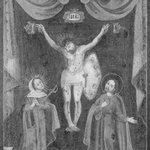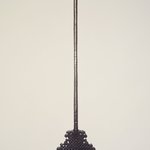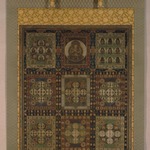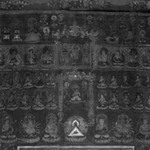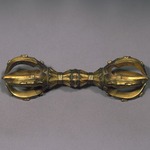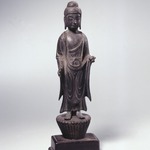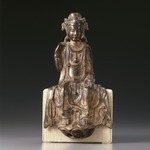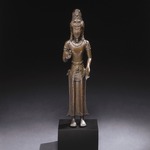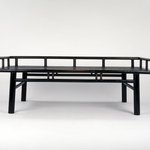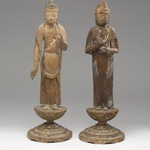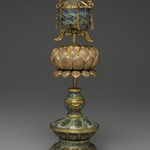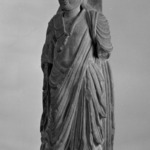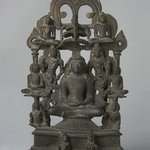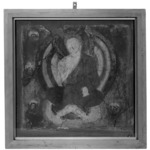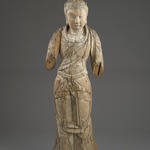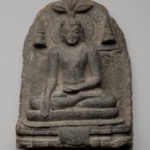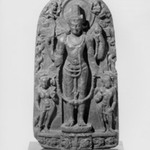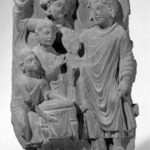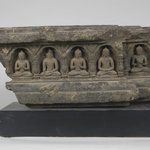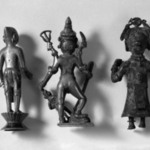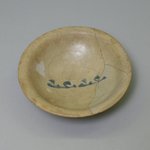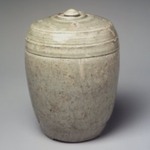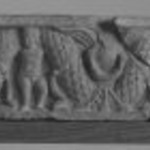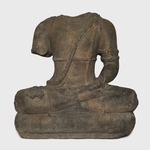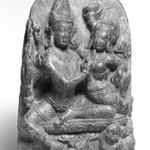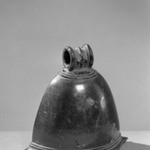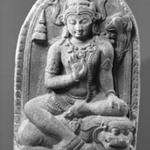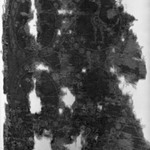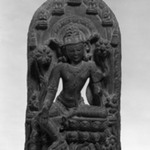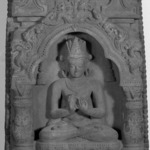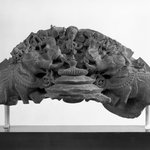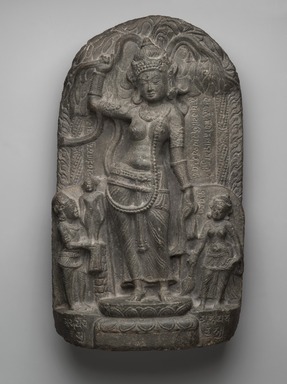
Nativity Scene: The Birth of the Buddha
Asian Art
On View: Asian Galleries, Southwest, 2nd floor
According to Buddhist scripture, Prince Siddhartha was born miraculously, emerging from his mother’s side as she stood under a tree. It was immediately clear from his appearance and behavior that he was a special child. He had a bump on his head (ushnisha), a spot between his eyes (urna), and a golden glow. The newborn also took seven steps.
MEDIUM
Gray schist
DATES
9th century
PERIOD
Pala Period
DIMENSIONS
15 1/2 x 9 x 4 1/8 in. (39.4 x 22.9 x 10.5 cm) (show scale)



COLLECTIONS
Asian Art
ACCESSION NUMBER
85.223.2
CREDIT LINE
Purchased with funds given by the Charles Bloom Foundation Inc. in memory of Charles and Mildred Bloom
CATALOGUE DESCRIPTION
A representation of Queen Maya giving birth to the Buddha (probably part of a set of reliefs depicting Buddha's life scenes) suggest the mid-9th century Nalanda stone sculpture style. The facial features and fleshy quality of the body show a close relation to pieces from that great Buddhist monastic and artistic center in Eastern India. While the tribhanga posture is not unusual for Pala stone images of Maya giving birth (see Huntingdon "The Pala-Sena Schools of Sculpture", 1984, pp. 112-113, fig. 128) the relaxed and animated pose is associated with the Nalanda Workshop. Iconographic and stylistic details (hair, headdress, costume, jewelry) recall other female Buddhist deities of the period from Eastern India as well. Unlike later Pala steles which typically have the central figure carve in higher relief than the side figures, this stele conforms to mid-ninth century style in its iconographic elements, precise carving, and careful spacing and equal emphasis on the carving of all figures.
The birth is depicted in an unconventional manner: rather than emerging from Queen Maya's right hip, the infant Siddhartha is depicted standing erect held at the left by Indra, King of the Gods. At the center, a large figure of Queen Maya stands holding a branch of the Sala Tree, which refers to the primordial tree goddess (Salabhanjika) who becomes fertile when she touches the branches of the tree. An inscription on the relief has not been translated. With the exception of several loans, the Museum does not have any exceptional Pala period reliefs, and those on loan which are largely iconic representations (whether Hindu or Buddhist) rather than narrative compositions. After the success of the Light of Asia exhibition, held at the Brooklyn Museum in 1984, we have sought such exemplary representations of Buddha's life. Arrived with its own wood base (not attached).
Condition: excellent. Minor abrasions at head of infant Buddha. Minor pitting of the surface throughout.
EXHIBITIONS
MUSEUM LOCATION
This item is on view in Asian Galleries, Southwest, 2nd floor
CAPTION
Nativity Scene: The Birth of the Buddha, 9th century. Gray schist, 15 1/2 x 9 x 4 1/8 in. (39.4 x 22.9 x 10.5 cm). Brooklyn Museum, Purchased with funds given by the Charles Bloom Foundation Inc. in memory of Charles and Mildred Bloom, 85.223.2. Creative Commons-BY (Photo: Brooklyn Museum, 85.223.2_PS2.jpg)
IMAGE
overall, 85.223.2_PS2.jpg. Brooklyn Museum photograph, 2011
"CUR" at the beginning of an image file name means that the image was created by a curatorial staff member. These study images may be digital point-and-shoot photographs, when we don\'t yet have high-quality studio photography, or they may be scans of older negatives, slides, or photographic prints, providing historical documentation of the object.
RIGHTS STATEMENT
Creative Commons-BY
You may download and use Brooklyn Museum images of this three-dimensional work in accordance with a Creative Commons license. Fair use, as understood under the United States Copyright Act, may also apply.
Please include caption information from this page and credit the Brooklyn Museum. If you need a high resolution file, please fill out our online application form (charges apply).
For further information about copyright, we recommend resources at the United States Library of Congress, Cornell University, Copyright and Cultural Institutions: Guidelines for U.S. Libraries, Archives, and Museums, and Copyright Watch.
For more information about the Museum's rights project, including how rights types are assigned, please see our blog posts on copyright.
If you have any information regarding this work and rights to it, please contact copyright@brooklynmuseum.org.
RECORD COMPLETENESS
Not every record you will find here is complete. More information is available for some works than for others, and some entries have been updated more recently. Records are frequently reviewed and revised, and we welcome any additional information you might have.
